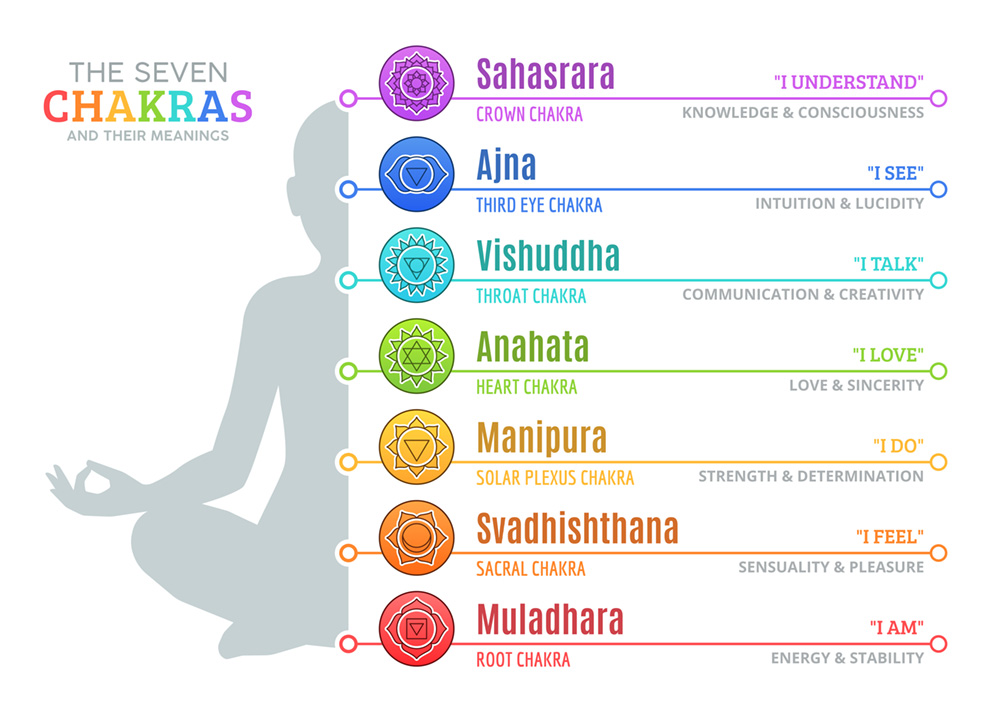Originating in India between the years 1500 – 500 BC, the word “chakra” translates to “wheel” in Sanskrit. Seven chakras make up the primary energetic system in the human body, and each chakra controls one of three bodily functions: physiological, psychological, and spiritual. “Prana,” meaning “pure healing energy” in Sanskrit, flows within each chakra.
Although some Hindu and Buddhist texts refer to the existence of hundreds of chakras, the seven major chakras form a linear path from the base of the spine up to the top of the head and are the most commonly mentioned.
These seven chakras are comprised of the following:
- The Root (Muladhara) is the chakra of stability, security, and basic needs. It is located at the base of the spine.
- The Sacral (Svadhishthana) is the chakra of sexuality, emotions, and creativity. It is located below the navel and around the pelvic floor.
- The Solar Plexus (Manipura) is the chakra of the digestive system and focuses on self-confidence and self-worth. It is located in the abdomen from the navel up to the ribcage.
- The Heart (Anahata) is the chakra of love, joy, and connection. It is known as the bridge between the lower and upper chakras, located in the chest encompassing the heart and lungs.
- The Throat (Vishuddha) is the chakra of communication, verbal expression, and speaking truth. It is located in the throat, including the thyroid, mouth, tongue, and jaw.
- The Third Eye (Ajna) is the chakra of intuition, imagination, and wisdom. It is located on the forehead between the eyebrows and governs the pituitary gland.
- The Crown (Sahasrara) is the chakra of spirituality, higher consciousness, and your divine self. It is located at the top of the head.
Chakras can become misaligned, creating instability throughout every aspect of your life. You may find that certain chakras are over or underactive, not to mention, your body naturally fluctuates often as well which can shift the energy of your chakras.
If you suspect you may be experiencing a negative misalignment in your chakras, take a deep breath and read on to learn about ways you can reestablish harmony.

- Establish self-awareness regarding each chakra.
Do an intuitive survey of your body, mind, and spirit–does anything feel “off?” Begin with the first chakra: the root chakra. Starting from the beginning can help you move through your system in a linear fashion and identify vulnerabilities within each chakra as you go.
For instance, if you experience a sore throat you may connect that to your throat chakra, while problems with your bowels can be attributed to the solar plexus chakra. Some issues are related to more than one chakra, such as depression, which is linked to your root, sacral, and third eye chakras.
- Turn to color meditation.
Meditation is always advantageous to the mind, body, and spirit. Color meditation utilizes the visualization of colors that correspond to each chakra. During your meditation session, imagine these colors glowing with a healing aura and radiating warmth from the location of your respective chakras:
- Root Chakra is red.
- Sacral Chakra is orange.
- Solar Plexus Chakra is yellow.
- Heart Chakra is green.
- Throat Chakra is blue.
- Third Eye Chakra is indigo.
- Crown Chakra is violet (or white).
- Observe and be mindful of the foods you eat.
Your diet can have a direct impact on your chakra system. Nourishing your body with a healthy diet is an easy way to effect positive change in your chakras, and paying attention to nutrition can treat and prevent imbalances. Here are a few food options that correspond to each chakra:
- Root Chakra – root vegetables, proteins, apples, beets, red pepper, pomegranate
- Sacral Chakra – liquids (water, broth, tea), foods high in carotenoids (carrots), mango, yams, ginger, turmeric
- Solar Plexus Chakra – complex carbohydrates, whole grains, bananas, squash, yellow lentils, corn
- Heart Chakra – green liquids, broccoli, kale, spinach, other leafy greens, kiwi
- Throat Chakra – blueberries, figs, soothing liquids such as herbal tea, coconut water, or raw honey
- Third Eye Chakra – blackberries, plums, purple grapes, goji berries, purple kale/cabbage, nuts, seeds
- Crown Chakra – Non-food needs such as pure air, sunlight, nature
- Take an invigorating sound bath.
The vibrations of various sound frequencies correlate with the seven chakras to aid in restoring a healthy flow of energy. Tibetan singing bowls are a perfect way to weave this into your daily rituals, or you may try a search online for sound frequencies connected to individual chakras. Sit back, relax, and tune in to the healing sounds.
- Give healing crystals a chance.
Several crystals in the world correspond to a chakra. In fact, more than one crystal can represent certain chakras, which offers you plenty of options when considering types, prices, and availability. When using crystal healing for your chakras, simply place the corresponding crystal on top of its respective chakra during meditation, or alternatively, create a gem elixir. Try these crystals for each chakra:
- Root Chakra – garnet, ruby, black tourmaline, black onyx
- Sacral Chakra – carnelian, citrine, amber, sunstone, fire opal
- Solar Plexus Chakra – citrine, yellow jasper, amber, tiger’s eye
- Heart Chakra – jade, peridot, emerald, green aventurine, rose quartz
- Throat Chakra – sodalite, turquoise, aquamarine, blue lace agate
- Third Eye Chakra – lapis lazuli, iolite, sapphire, kyanite
- Crown Chakra – amethyst, tanzanite, labradorite, clear quartz
- Try incorporating essential oils.
Just like crystals, each essential oil coincides with a chakra as well, and similarly, there are multiple selections on the plate for you to choose between. Apply the essential oil (mixed with a carrier oil such as coconut, jojoba, or grapeseed oil) to your skin to match up with the following chakras:
- Root Chakra – cypress or sandalwood, applied at base of spine or bottom of feet
- Sacral Chakra – clary sage or patchouli, applied just below the navel
- Solar Plexus Chakra – juniper or lemongrass, applied above the navel
- Heart Chakra – rose or jasmine, applied on the chest or over the heart
- Throat Chakra – bergamot or chamomile, applied on the neck
- Third Eye Chakra – lavender or cedarwood, applied between the brows
- Crown Chakra – frankincense or myrrh, applied on top of the head
Taking the time to understand and rebalance your chakra system is crucial to enjoying a wholesome and thriving life. Harmony within your energetic body brings harmony to your mind, body, and spirit. The more you practice these tips for re-aligning your chakras, the easier it will get and you will ultimately feel a fulfilled sense of well-being.





0 Comments